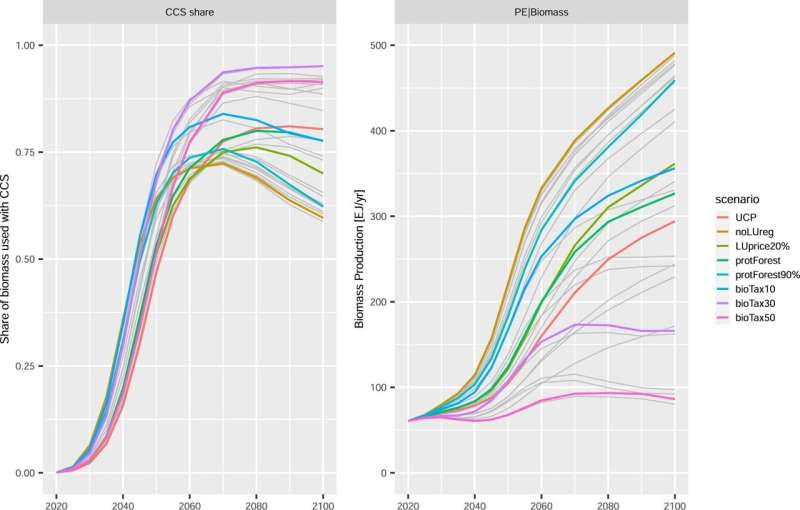This article has been reviewed according to Science X's editorial process and policies. Editors have highlighted the following attributes while ensuring the content's credibility:
fact-checked
peer-reviewed publication
trusted source
proofread
Study investigates effect of different land-use, energy sector policies on bioenergy emissions

Demand for modern biofuels is expected to grow substantially in order to mitigate climate emissions. However, they are far from being a climate neutral alternative to gasoline and diesel. A new study published in Nature Climate Change shows that under current land-use regulations, CO2 emission factors for biofuels might even exceed those for fossil diesel combustion due to large-scale land clearing related to growing biomass.
Before bioenergy can effectively contribute to achieving carbon neutrality, international agreements need to ensure the effective protection of forests and other natural lands by introducing carbon pricing, the expert team from the Potsdam Institute for Climate Impact Research (PIK) argues.
"Our results show: The state of current global land regulation is inadequate to control land-use-change emissions from modern biofuels," lead author Leon Merfort explains. "If cultivation for bioenergy grasses is not strictly limited to marginal or abandoned land, food production could shift and agricultural land use expand into natural land. This would cause substantial carbon dioxide emissions due to forest clearing in regions with weak or no land regulation."
These indirect effects of bioenergy use are a challenge for policy makers, as food and bioenergy markets are globally connected but beyond the control of individual national policies. Tragically, the regulatory gap in the land-use sector would keep bioenergy supply cheap, while pushing the energy sector to phase-out fossil fuels even faster to compensate for additional emissions from land-use change. This spiral in turn increases the demand for bioenergy.
To investigate the implications of bioenergy induced land-use change emissions under sectorally fragmented policies, the researchers coupled energy and land system models to derive alternative transformation pathways consistent with limiting global warming to well below 2°C. These pathways include varying assumptions on land-use and energy policies, as these have a large influence on CO2 emissions from land-use change and also affect the amount of bioenergy used to fulfill the global energy demand.
By comparing these scenarios with a corresponding counterfactual scenario with no bioenergy production and hence lower land-use-change emissions, the researchers were able to derive emission factors, which attribute CO2 emissions from land-use change to bioenergy production in the light of different policy frameworks.
Putting a price on emissions from land-use change to achieve climate neutrality
"We find that without additional land-use regulation, land clearing related to the production of modern biofuels results in CO2 emission factors—averaged over a 30-year period—that are higher than those from burning fossil diesel," co-author Florian Humpenöder says. These results underline the need for a paradigm shift in land-use policy. "Our results show that a globally comprehensive land protection or carbon pricing scheme would avoid high CO2 emissions from land-use change related to the production of modern biomass."
"Phasing out fossil fuels will generate demands of bioenergy worth hundreds of billions of dollars by mid-century ", co-author Nico Bauer says. "The agricultural sector will try to take advantage of these new opportunities, but potential expansion into high-yield areas often coincides with high upfront CO2 emissions from land conversion. Only reducing the demand for bioenergy will not solve this problem. Surprisingly, we also find that the protection of 90% of all global forest areas is not enough because the remaining 10% would still be too big of a loophole."
What is crucial is not the price level itself, but the comprehensiveness to cover nearly 100% of all forests and other natural lands, the research team finds. Pricing all emissions from land-use change with only 20% of the CO2 price in the energy system is more effective than a protection scheme covering 90% of all forests globally.
The protection of carbon stored in existing forests should be placed high on the international policy agenda as fossil fuel phase-out progresses and regulations in the land-use sector lag behind, Bauer stresses. "Our results show that bioenergy can be produced with limited emissions under effective land-use regulations. Yet, if the regulatory gap remains wide open, bioenergy will not be part of the solution to mitigate climate change, but part of the problem."
More information: Leon Merfort et al, Bioenergy-induced land-use-change emissions with sectorally fragmented policies, Nature Climate Change (2023). DOI: 10.1038/s41558-023-01697-2
Journal information: Nature Climate Change
Provided by Potsdam Institute for Climate Impact Research




















